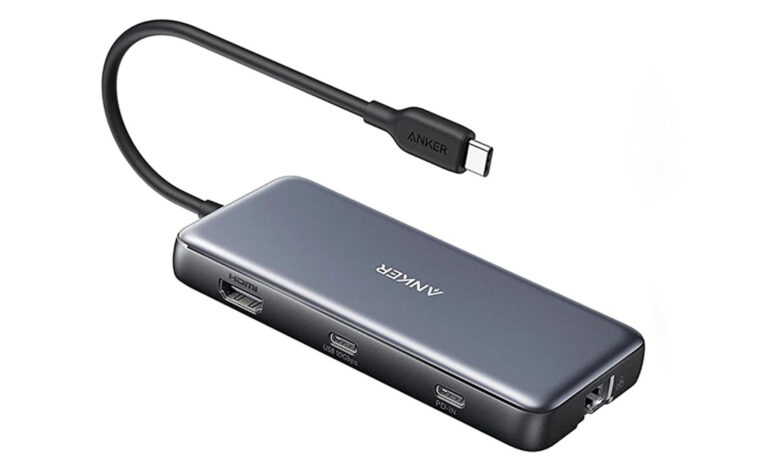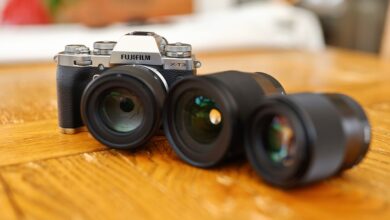Mobile connectivity: We review the Anker 555 USB-C Hub (8 in 1)

While the ports on modern laptops are sufficient for most users, photographers and filmmakers have much higher connectivity needs than the average person. A mobile hub can be a lifesaver for creatives on the go. In this review, we look at the Anker 555 USB-C 8-in-1 Hub and whether it can deliver both the ports and performance for a demanding workflow.
I have always been a fan of Anker products. They offer some of the best and most reliable charging products, and I have quite a few of them around my home and in my office. However, they make quite a few products other than charging devices, so when I need a hub for MacBook AirIt was an easy choice.
I had some specific needs. First, I need Ethernet, because Wi-Fi in some places where I work can sometimes be a bit slow and unstable. Second, I need HDMI so I can easily connect to the TV when teaching. That combination alone eliminates a lot of options. Finally, I want to transmit power across the line. The Anker 555 USB-C 8 in 1 Hub fit the bill and based on the reliability of their other products, it’s a sensible choice.
Specifications
Ports
- HDMI port delivers 4K at 60 Hz
- Two USB-A 3.2 ports with 10 Gbps throughput each
- USB-C 3.2 port with 10 Gbps throughput
- USB-C input delivers 100 watts
- Charge up to 85 watts
- Ethernet port with 1 Gbps bandwidth
- SD port at 104 MBps
- MicroSD port at 104 MBps
Other
- Dimensions: 4.76 x 2.17 x 0.6 inches
- Weight: 4.5 ounces
Design
The hub is very small and light, just bigger than the size of all the ports combined, a big plus for anyone considering the size and weight of what they’re moving. Its host cord is about 6 inches (15 cm) long and fairly stiff. The hub itself is solid, dark plastic with a small silver Anker logo and subtle black labels on each port. A small, white status light sits at one end. Both the USB-A ports and both card slots are on one side, while the PD, USB-C and HDMI ports are on the other. The Ethernet port is on the far end.
 It’s a carefully designed layout. My only quirk is the lack of any rubber feet or the like. Its plastic case is sleek and the device is light, so expect it to slide around a bit under the strain of whatever you’ve connected it to. If it bothers you, you can buy sticky rubber feet for a few dollars.
It’s a carefully designed layout. My only quirk is the lack of any rubber feet or the like. Its plastic case is sleek and the device is light, so expect it to slide around a bit under the strain of whatever you’ve connected it to. If it bothers you, you can buy sticky rubber feet for a few dollars.
Performance
Power
From a 100-watt input, the Anker hub takes 15 watts to run everything and delivers 85 watts for charging. For most computers, this is a lot of power. For example, my MacBook Air can fast charge at 67 watts, which means the hub can give me 50% of battery life in just 30 minutes. Larger laptops, like the 16-inch MacBook Pro, require a bit more power. For example, the aforementioned model takes 96 watts to charge at a typical rate. This means that if you’re driving a power-hungry laptop at full speed for long periods of time, the hub won’t be able to keep up, but this is rare. It should be noted, however, that the hub doesn’t come with a USB-C cable or power adapter, so if you want to take advantage of pass-through power delivery, you’ll need to bring those as well.
Display
The HDMI port delivers 4K at 60 Hz, which is an advantage over many other portable hubs, which typically max out at 30 Hz. That may not matter too much to a photographer, but if you’re editing high frame rate video, gaming, or doing anything that benefits a faster refresh rate, you’ll appreciate it. high on that change. While not everyone needs an HDMI port on a hub for the computer they go with, I would love to have it. For example, I can display Powerpoint in class while keeping notes on my screen. Or, you can simply mirror your monitors to a larger monitor, or set them up as two separate monitors for more workspace. It is very handy and it works perfectly in practice.

USB
With USB-C gradually taking over USB-A, most of us have a need for both ports, myself included. Therefore, the inclusion of two USB-A ports and one USB-C port, all with 10 Gbps bandwidth, is appreciated here, as it saves you from having to carry around multiple adapters or buy new cables. . And in fact, the hub has no problem meeting the demands of high-speed SSDs, easily maintaining the fastest speeds possible, which is great news for those who regularly transfer a lot. data.
Ethernet
A lot of people haven’t used an Ethernet port in years. Wi-Fi is quite reliable and fast enough for many applications today. That being said, for those of us who often move extremely large files or can’t always access a fast Wi-Fi network, having Ethernet available is a real lifesaver. the. Both of those things apply to me, and that’s why the Ethernet port is a break for me when choosing a hub. During use, the port reached its advertised bandwidth of 1 Gbps, and combined with a slim cable, it ensured I could always use a fast and reliable wired connection if I wanted to.
Card reader
No promotional hub would be complete without at least an SD card reader, and the Anker hub comes with both that device and a microSD reader. Both max out at 104 MBps, which won’t maximize the capabilities of the UHS-II card, but should be plenty for most file loading tasks.
What I like
- Very compact footprint
- Light
- A great variety of portals
- Output 4K 60 HZ via HDMI
- Pass-through charging 85 watts
- Minimalist design
What I don’t like
Final thoughts and purchase
Overall, the Anker 555 USB-C 8-in-1 Hub strikes the right balance in a mobility hub, keeping its size and weight compact, but includes a sleek array of ports to meet your needs. requirements of any creation on the go and combine it with performance that can keep up with demanding workflows. And at $80, it’s easy to recommend.




